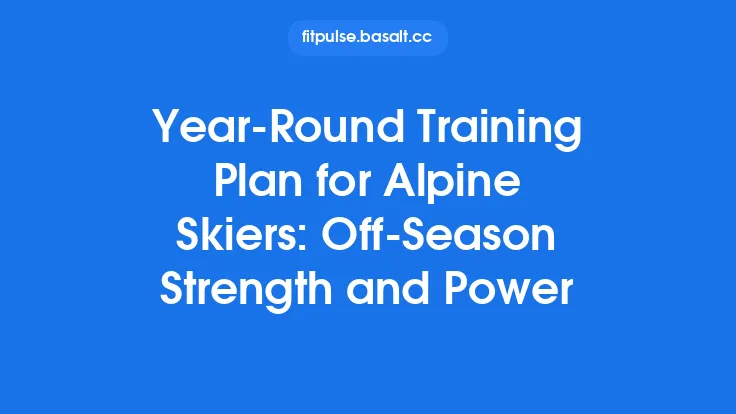Dryland training is an essential pillar of a swimmer’s overall development, yet it often receives less attention than the hours spent slicing through the water. While the pool refines technique and builds aerobic capacity, the land‑based component supplies the structural foundation that allows those technical gains to translate into speed, efficiency, and durability. By systematically targeting the core, mobility, and power systems, swimmers can improve body alignment, generate stronger propulsive forces, and reduce the risk of compensatory movement patterns that lead to fatigue or injury. This article delves into the science and practicalities of dryland strength training for swimmers, offering a comprehensive roadmap that can be adapted to athletes of any level—from high‑school hopefuls to elite Olympians.
Why Dryland Training Matters for Swimmers
- Neuromuscular Transfer
The swimming stroke is a coordinated sequence of muscle activations that begins on land. A well‑conditioned neuromuscular system can fire motor units more rapidly and with greater precision, resulting in a more forceful catch and pull phase.
- Force Production vs. Drag Reduction
In the water, speed is the product of the force a swimmer can apply against the water and the drag they experience. Dryland power increases the former, while core stability and mobility help maintain a streamlined profile, minimizing the latter.
- Injury Mitigation
Although the focus here is not on injury prevention per se, a balanced program that strengthens the posterior chain, scapular stabilizers, and hip rotators inherently supports joint health and reduces the likelihood of overuse syndromes.
- Performance Consistency
Land‑based strength provides a buffer against the fatigue that inevitably sets in during long training sessions, allowing swimmers to maintain technique quality throughout a race.
Core Development: Foundations for Stability and Propulsion
A strong, resilient core is the linchpin of efficient swimming. It acts as the conduit through which force generated by the legs and arms is transferred to the torso, and it stabilizes the spine during the high‑velocity rotations of each stroke.
Key Core Qualities
| Quality | Relevance to Swimming | Typical Assessment |
|---|---|---|
| Isometric Stability | Maintains a neutral spine during the pull and kick phases | Plank hold time, dead‑bug control |
| Dynamic Rotational Power | Drives body roll in freestyle and backstroke | Medicine ball rotational throws |
| Anterior‑Posterior Balance | Prevents excessive lumbar extension during the catch | Hollow hold vs. super‑man hold duration |
| Lateral Control | Supports hip rotation and kick alignment | Side plank with hip dip |
Core Exercise Selection
| Exercise | Primary Muscles | Implementation Tips |
|---|---|---|
| Front & Side Planks (with variations) | Rectus abdominis, obliques, transverse abdominis | Progress from static holds (30 s) to dynamic movements (leg lifts, shoulder taps). Keep scapula retracted to avoid shoulder strain. |
| Dead‑Bug | Deep core stabilizers, hip flexors | Perform slowly, ensuring the lower back remains in contact with the floor throughout each arm/leg extension. |
| Pallof Press | Anti‑rotation core, lats | Use a cable or resistance band; maintain a rigid torso while resisting rotational pull. |
| Russian Twists (Weighted) | Obliques, hip flexors | Keep the spine neutral; avoid excessive lumbar flexion by hinging at the hips. |
| Medicine Ball Rotational Throws | Rotational power, posterior chain | Throw the ball from a semi‑rotated stance, emphasizing a hip‑driven motion rather than arm‑only. |
| Hollow Body Holds | Core endurance, posterior chain | Engage glutes and hamstrings to protect the lower back; aim for a “boat” shape with no sagging. |
Programming Core Work
- Frequency: 3–4 sessions per week, integrated into warm‑up or dedicated strength blocks.
- Volume: 2–3 sets of each exercise, 30–60 seconds per hold or 8–12 repetitions for dynamic moves.
- Progression: Increase hold time, add external load (e.g., weighted vest), or introduce instability (e.g., Swiss ball, BOSU) once baseline proficiency is achieved.
Mobility Work: Enhancing Range of Motion for Efficient Stroke Mechanics
Mobility is the ability of a joint to move through its full, pain‑free range while maintaining control. For swimmers, optimal mobility in the shoulders, thoracic spine, hips, and ankles is crucial for achieving the long, powerful strokes that reduce drag and increase propulsion.
Targeted Mobility Areas
| Joint/Region | Desired Motion | Why It Matters |
|---|---|---|
| Shoulder (Glenohumeral) | Full flexion/extension, external rotation, scapular upward rotation | Enables a high elbow catch and efficient recovery. |
| Thoracic Spine | Extension and rotation | Facilitates body roll and a streamlined torso position. |
| Hip Flexors & Extensors | Flexion, extension, internal/external rotation | Supports a strong kick and proper body alignment. |
| Ankle Dorsiflexion | Adequate dorsiflexion | Improves foot placement during the kick and reduces drag. |
Mobility Drills and Techniques
| Drill | Execution | Frequency |
|---|---|---|
| Band‑Assisted Shoulder Dislocates | Hold a light resistance band with a wide grip; raise overhead and continue to a behind‑back position, keeping arms straight. | 2 × 10 reps, daily. |
| Scapular Wall Slides | Stand with back against a wall, elbows at 90°, slide arms upward while maintaining contact. | 2 × 8 reps, 3×/week. |
| Thoracic Foam Rolling | Lie on a foam roller placed horizontally across the thoracic spine; roll gently from T2 to T12. | 1–2 min per session, post‑workout. |
| Hip 90/90 Rotations | Sit with one hip flexed to 90° and the other extended to 90°; rotate torso toward the front leg, then the back leg. | 2 × 8 reps each side, 3×/week. |
| Ankle Dorsiflexion Lunge Stretch | Kneel with one foot forward; drive knee over toes while keeping heel planted. | 2 × 30 s per side, daily. |
| Dynamic Cat‑Cow with Reach | In quadruped position, alternate arching and rounding the back while reaching opposite arm forward. | 2 × 10 reps, warm‑up. |
Integrating Mobility into the Training Cycle
- Pre‑Pool Warm‑Up: 5–10 minutes of dynamic mobility to prime the joints for water work.
- Post‑Strength Session: Static or myofascial release techniques to maintain tissue pliability.
- Recovery Days: Longer, low‑intensity mobility sessions (15–20 minutes) to promote joint health.
Power Generation: Translating Strength to the Water
Power is the product of force and velocity. In swimming, the ability to produce high‑velocity force during the pull, kick, and body roll directly influences race times. Dryland power training focuses on developing explosive strength in the muscle groups most responsible for propulsive force.
Primary Power Muscles for Swimmers
- Posterior Chain: Gluteus maximus, hamstrings, erector spinae (critical for hip extension and body roll).
- Upper Body Pullers: Latissimus dorsi, teres major, posterior deltoid (drive the pull phase).
- Core Rotators: Obliques, multifidus (facilitate rapid torso rotation).
- Leg Extensors: Quadriceps, calves (support a strong flutter or dolphin kick).
Power‑Focused Exercise Modalities
| Modality | Example Exercise | Key Parameters |
|---|---|---|
| Olympic‑Style Lifts | Power Clean, Hang Snatch | 3–5 sets × 3–5 reps, 70–85 % 1RM, 2–3 min rest |
| Plyometrics | Box Jumps, Depth Jumps, Medicine Ball Slams | 3–4 sets × 5–8 reps, maximal effort, 90 s rest |
| Weighted Plyo‑Pushes | Plyometric Push‑Ups with weight vest | 3 sets × 6–10 reps, focus on minimal ground contact |
| Contrast Training | Pair a heavy squat (5 RM) with a jump squat (bodyweight) | 1 heavy set → 1 explosive set, 3–4 cycles |
| Cable or Band Explosives | Standing cable row with a rapid concentric phase | 3 sets × 8–10 reps, emphasize speed on pull |
Programming Power Sessions
- Frequency: 1–2 dedicated power days per week, spaced at least 48 hours from heavy lower‑body strength sessions to preserve recovery.
- Periodization:
- Accumulation Phase (4–6 weeks): Emphasize foundational strength (3–5 RM) with moderate volume.
- Transformation Phase (3–4 weeks): Introduce contrast and plyometric work, reducing load but increasing speed.
- Peak Phase (2 weeks): Focus on low‑volume, high‑velocity movements; taper volume to avoid fatigue before competition.
- Rest Intervals: Longer rest (2–3 minutes) between heavy sets to maintain power output; shorter rest (60–90 seconds) for plyometric clusters.
Translating Land Power to Water
- Movement Specificity: Align the direction of force production on land with the swimming plane. For example, a vertical jump mimics the explosive hip extension needed for a dolphin kick.
- Neuromuscular Priming: Perform a brief power activation (e.g., 2–3 medicine‑ball slams) immediately before a high‑intensity swim set to “carry over” the heightened motor unit recruitment.
- Timing: Schedule power sessions 24–48 hours before key swim workouts to allow for recovery while still benefiting from the potentiated state.
Designing a Balanced Dryland Program
A well‑structured dryland regimen integrates core stability, mobility, and power without overloading any single system. Below is a template that can be customized based on the athlete’s training age, competition schedule, and available equipment.
Weekly Layout Example (Intermediate Swimmer)
| Day | Focus | Sample Session |
|---|---|---|
| Monday | Core + Mobility | Warm‑up (dynamic mobility 10 min) → Core circuit (plank variations, dead‑bug, Pallof press) 3 × 30 s each → Mobility finisher (band shoulder dislocates, thoracic foam roll) |
| Tuesday | Lower‑Body Strength + Power | Squat (4 × 5 @ 80 % 1RM) → Romanian deadlift (3 × 6) → Box jumps (3 × 5) → Hip mobility drills |
| Wednesday | Active Recovery / Mobility | Light cardio (10 min) → Full‑body mobility flow (15 min) → Core endurance (hollow hold, side plank) |
| Thursday | Upper‑Body Strength + Power | Pull‑up weighted (4 × 4) → Bench press (3 × 5) → Medicine ball rotational throws (3 × 8/side) → Scapular wall slides |
| Friday | Core + Power | Warm‑up (dynamic) → Power clean (5 × 3) → Core circuit (Russian twists, Pallof press) → Plyometric push‑ups (3 × 8) |
| Saturday | Swim‑Specific Dryland (Combined) | Resistance band swim pulls (3 × 20 m) → Land‑based kick drills (jump squats) → Mobility circuit (shoulder, hip) |
| Sunday | Rest or Light Activity | Optional yoga, swimming low‑intensity, or complete rest |
Key Principles
- Progressive Overload: Incrementally increase load, volume, or complexity every 2–3 weeks.
- Recovery Management: Use lighter mobility or core days to facilitate recovery while still reinforcing neuromuscular patterns.
- Individualization: Adjust set/rep schemes based on the swimmer’s strength baseline and competition timeline.
Progression and Periodization Strategies
Linear vs. Undulating Models
- Linear Periodization: Gradually shifts from high volume/low intensity to low volume/high intensity across a macrocycle. Works well for athletes with a clear competition peak.
- Undulating (Wave) Periodization: Alternates intensity and volume on a weekly or bi‑weekly basis, providing frequent stimulus variation. Beneficial for swimmers who need to maintain high training volumes in the pool while still developing strength.
Sample 12‑Week Macrocycle
| Phase | Weeks | Primary Goal | Typical Load (Relative to 1RM) | Volume (Sets × Reps) |
|---|---|---|---|---|
| General Preparation | 1‑4 | Build foundational strength & mobility | 65‑75 % | 4 × 10 |
| Strength‑Endurance | 5‑8 | Increase muscular endurance for longer sets | 70‑80 % | 3 × 8 |
| Power Development | 9‑10 | Convert strength to explosive output | 80‑90 % (heavy) + plyometrics | 3 × 5 (heavy) + 3 × 5 (explosive) |
| Taper/Peak | 11‑12 | Maintain power, reduce fatigue | 60‑70 % (light) + low‑volume plyometrics | 2 × 6 + 2 × 4 |
Monitoring Load
- RPE (Rate of Perceived Exertion): Track subjective effort for each session; aim for 6–8 on a 10‑point scale during heavy phases.
- Velocity‑Based Training (VBT): Use a linear position transducer or wearable accelerometer to ensure movement speed remains high during power sets.
- Session RPE (sRPE): Multiply RPE by session duration to gauge overall training stress and adjust subsequent days accordingly.
Assessment and Monitoring
Objective testing provides feedback on the effectiveness of the dryland program and highlights areas needing attention.
| Test | Targeted Attribute | Protocol |
|---|---|---|
| Plank Hold | Core endurance | Hold a forearm plank with neutral spine; record max time. |
| Standing Long Jump | Lower‑body power | Perform a maximal horizontal jump; measure distance. |
| Medicine Ball Rotational Throw Distance | Rotational power | From a semi‑rotated stance, throw a 4 kg ball as far as possible. |
| Shoulder Flexion/External Rotation ROM (goniometer) | Mobility | Measure active range; compare to normative values. |
| Hip Internal/External Rotation (seated) | Hip mobility | Use a goniometer; assess each side. |
| 1RM Back Squat | Maximal strength | Standardized protocol; ensure proper technique. |
Frequency: Conduct baseline testing at the start of the macrocycle, mid‑cycle re‑assessment, and post‑season evaluation. Use the data to adjust load percentages and exercise selection.
Common Pitfalls and How to Avoid Them
- Overemphasizing Upper‑Body Hypertrophy
Swimmers benefit more from functional strength than bulk. Keep rep ranges moderate (6–12) and prioritize multi‑planar movements.
- Neglecting Mobility After Heavy Lifts
Heavy loading can temporarily reduce joint range. Pair each strength session with a brief mobility cooldown to preserve flexibility.
- Insufficient Rest Between Power Sets
Power output drops dramatically with inadequate recovery. Respect 2–3 minute rest intervals for maximal force production.
- Lack of Transfer Specificity
Generic gym exercises may not translate well. Incorporate swim‑specific drills (e.g., banded swim pulls, resisted kick drills) to bridge the gap.
- Training in Isolation from Pool Sessions
Schedule dryland work to complement, not conflict with, swim intensity. For example, avoid heavy leg days immediately before a high‑volume kick set.
Integrating Dryland Sessions with Pool Workouts
- Same‑Day Pairing:
- Morning: High‑intensity swim set (e.g., sprint intervals).
- Afternoon: Light core and mobility work to aid recovery and reinforce technique.
- Separate‑Day Pairing:
- Day 1: Heavy lower‑body strength.
- Day 2: Swim endurance focus.
- Day 3: Upper‑body power + swim technique.
- Pre‑Competition Taper:
Reduce dryland volume by 40‑50 % while maintaining intensity (e.g., 2‑set power cleans at 80 % 1RM) to keep neuromuscular activation without inducing fatigue.
Equipment and Facility Considerations
| Equipment | Purpose | Alternatives |
|---|---|---|
| Adjustable Dumbbells/Kettlebells | Load progression for core and power drills | Sandbags, medicine balls |
| Resistance Bands (light to heavy) | Mobility, scapular activation, swim‑specific pulls | Tubing, elastic cords |
| Pull‑Up Bar | Upper‑body pulling strength | Gymnastic rings |
| Squat Rack & Bench | Heavy compound lifts | Power rack, smith machine |
| Foam Roller / Lacrosse Ball | Myofascial release for mobility | Massage stick |
| Linear Position Transducer or Accelerometer | Velocity monitoring for power work | Smartphone apps with video analysis |
| Weighted Vest | Add load to plyometrics and core holds | Ankle/wrist weights |
A modest home gym can satisfy most needs, but access to a fully equipped facility allows for more advanced lifts (e.g., Olympic lifts) and heavier loading.
Sample Weekly Layout (Advanced Athlete)
| Day | Session | Details |
|---|---|---|
| Monday | Core + Mobility | 10 min dynamic warm‑up → 4 × 30 s front plank with shoulder taps → 3 × 12 dead‑bug → 3 × 15 Pallof press each side → 10 min shoulder/ thoracic mobility circuit |
| Tuesday | Lower‑Body Strength + Power | 5 × 3 power cleans (80 % 1RM) → 4 × 5 back squat (85 % 1RM) → 3 × 5 box jumps (24‑in) → 2 × 10 hip flexor stretch |
| Wednesday | Active Recovery | 30 min low‑intensity swim (technique focus) → 15 min full‑body foam rolling |
| Thursday | Upper‑Body Strength + Power | 4 × 5 weighted pull‑ups → 3 × 6 bench press (80 % 1RM) → 3 × 8 medicine‑ball rotational throws (6 kg) → 3 × 10 scapular wall slides |
| Friday | Core + Explosive Conditioning | 3 × 8 Russian twists (10 kg) → 3 × 6 hanging leg raises → 4 × 5 plyometric push‑ups → 2 × 30 s side plank with hip dip |
| Saturday | Swim‑Specific Dryland | 3 × 20 m resisted swim pulls with band → 3 × 10 jump squats (bodyweight) → 3 × 15 ankle dorsiflexion lunges → 10 min thoracic mobility flow |
| Sunday | Rest | Complete rest or optional gentle yoga |
Final Thoughts
Dryland training is not an ancillary add‑on; it is a strategic component that amplifies a swimmer’s capacity to move efficiently, generate force, and sustain high‑quality technique under fatigue. By systematically developing a resilient core, preserving optimal joint mobility, and cultivating explosive power, swimmers can unlock performance gains that are difficult to achieve through pool work alone. The key lies in thoughtful programming—balancing load, volume, and specificity—while continuously monitoring progress and adjusting to the demands of the competitive calendar. When executed with precision, a well‑designed dryland regimen becomes the hidden engine that propels swimmers from good to great, season after season.





